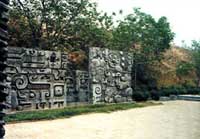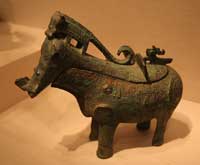 The Shang Dynasty arose during the Bronze Age in China. Thousands of archaeological finds in the Yellow River valley, the cradle of Chinese civilization, provide evidence about the Shang Dynasty, which ruled roughly from the 16th to the 11th century BC. A rebel leader who overthrew the previous Xia Dynasty founded the Shang Dynasty. The Shang controlled only the central part of China, present day Henan Province. However, the Shang influence extended beyond the state's borders, and Shang art motifs are found in artifacts from more distant regions. The Shang culture was based on agriculture and animal husbandry.
The Shang Dynasty arose during the Bronze Age in China. Thousands of archaeological finds in the Yellow River valley, the cradle of Chinese civilization, provide evidence about the Shang Dynasty, which ruled roughly from the 16th to the 11th century BC. A rebel leader who overthrew the previous Xia Dynasty founded the Shang Dynasty. The Shang controlled only the central part of China, present day Henan Province. However, the Shang influence extended beyond the state's borders, and Shang art motifs are found in artifacts from more distant regions. The Shang culture was based on agriculture and animal husbandry.
The Shang kings were the country's religious and political leader. They ruled through dynastic alliances. The Shang people were often at war with neighboring peoples and moved their capital several times. Shang kings mobilized large armies for warfare and huge numbers of workers to construct defensive walls and elaborate tombs.
 Two important features of this dynasty were the development of a writing system, which has been found on tortoise shells and flat cattle bones (commonly called oracle bones), and the use of bronze metallurgy. In the early 20th century, the archaeological discovery of the Shang oracle-bone inscriptions with records of the king's predictions on topics such as the weather and harvests, proved the historical existence of this Chinese dynasty. The workmanship on a number of ceremonial bronze vessels with inscriptions and bronze weapons dating from the Shang attests to a high level of civilization.
Two important features of this dynasty were the development of a writing system, which has been found on tortoise shells and flat cattle bones (commonly called oracle bones), and the use of bronze metallurgy. In the early 20th century, the archaeological discovery of the Shang oracle-bone inscriptions with records of the king's predictions on topics such as the weather and harvests, proved the historical existence of this Chinese dynasty. The workmanship on a number of ceremonial bronze vessels with inscriptions and bronze weapons dating from the Shang attests to a high level of civilization.
The writing system used by the Shang is the ancestor of the modern Chinese writing system, with symbols or characters for each word. This writing system evolved over time, but it never became a purely phonetic system like the Roman alphabet, which uses letters to represent specific sounds. Thus mastering the written language required learning to recognize and write several thousand characters, making literacy a highly specialized skill requiring many years to master fully.
The Shang used bronze more for purposes of ritual than war. Although some bronze weapons have been found, most of the surviving Shang bronze objects are cups, goblets, steamers, and cauldrons, presumably made for use in sacrificial rituals. They were beautifully formed in a great variety of shapes and sizes and decorated with images of wild animals. The bronze industry required centralized coordination of a large labor force to mine, refine, and transport copper, tin, and lead ores, as well as to produce and transport charcoal. It also required technically skilled artisans to make clay models, construct ceramic molds, and assemble and finish vessels, the largest which weighed as much as 800 kg.

